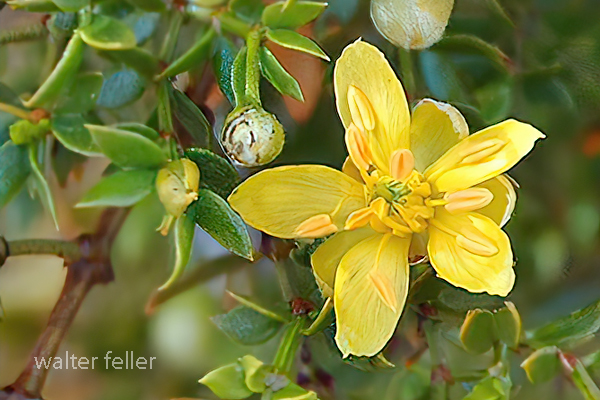Creosote
Larrea tridentata
Creosote is one of the most iconic and enduring plants of the American Southwest. Found throughout the Mojave, Sonoran, and Chihuahuan Deserts, it’s a true desert survivor—tough, long-lived, and deeply woven into the history and ecology of the region.
Appearance:
A rounded, evergreen shrub that typically grows 3 to 6 feet tall, though some can grow larger. Its small, waxy green leaves are coated in a resin that smells strongly of rain on dry earth—especially after a desert storm. In spring, it produces small, bright yellow flowers, followed by fuzzy white seed capsules.
Habitat:
Common on desert flats, alluvial fans, and gravelly slopes. It thrives in poor, dry soils with full sun exposure and little water. Often forms vast stands called “creosote rings,” some of which are thousands of years old.
Bloom Time:
Primarily blooms from March to May, but can bloom again after summer rains.
Ecological Role:
Supports native insects, birds, and mammals. It stabilizes soil, provides shelter, and even has natural antibacterial properties in its leaves.
Cultural and Medicinal Use:
Used by Native American tribes for a wide range of purposes—treating infections, soothing colds, easing joint pain, and more. A tea made from the leaves was once common in traditional desert medicine, though the plant is very bitter and not typically used in modern herbalism without caution.
Note:
Creosote’s scent is unforgettable, especially when the rain hits. It’s often called “the smell of the desert” and is as much a part of the Southwest as sand and sun. Larrea tridentata, known as Creosote Bush is a flowering plant in the family Zygophyllaceae. It is a prominent species in the Mojave, Sonoran, and Chihuahuan Deserts of western North America, including portions of California, Arizona, Nevada, Utah, New Mexico and western Texas in the United States, and northern Chihuahua in Mexico. In California it is found from Inyo County southward in desert areas only.
It is an evergreen shrub growing to 1-3 meter tall, rarely 4 meter. The stems of the plant bear resinous, dark green leaves with two leaflets joined at the base, each leaflet 7-18 millimeter long and 4-8.5 millimeter broad. The yellow flowers are up to 25 millimeter diameter, with five yellow petals. The plant is extraordinarily tolerant of drought, saline or alkaline soils, and adapted to desert conditions.
It reproduces by seed and also by sending up new shoots from the roots. The latter results in the creation of clonal rings, some of which are among the oldest known plants at around 11,000 years. Galls may form by the activity of the creosote gall midge. The whole plant exhibits a characteristic odor of creosote (especially when wet), from which the common name derives. Native people use the plant for medicinal purposes.
Calscape
https://calscape.org/Larrea-tridentata-(Creosote-Bush)